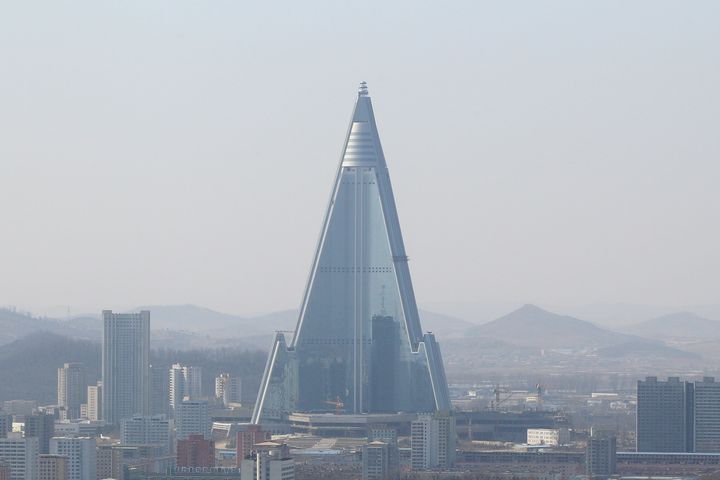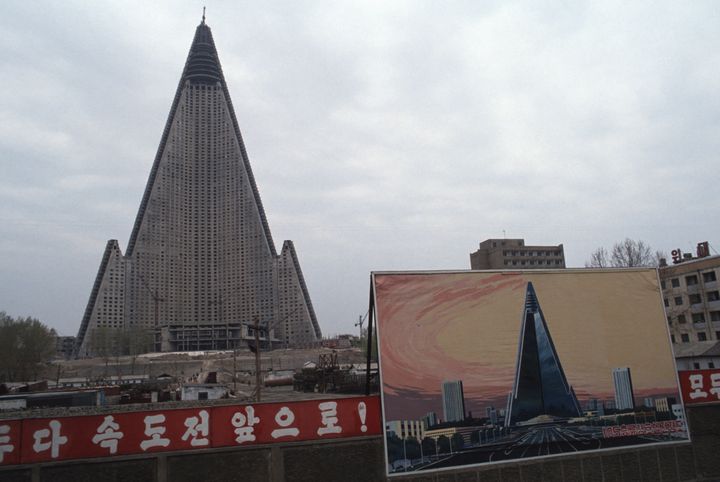It went from an intended grandiose monument of North Korea to being dubbed by locals ‘The Hotel of Doom’, but now Pyongyang looks like it may finally be ready to open the capital’s biggest landmark.
Construction on the 105-storey Ryugyong Hotel, which remains the world’s tallest unoccupied building, began in 1987 when Kim Jong Un’s grandfather Kim Il Sung, North Korea’s founder and “eternal president,” was still alive.
It was due to open its doors in 1989 and would have been the world’s tallest hotel - surpassing another in Singapore that was built by a South Korean company.

But a severe economic crash and famines in the 1990s left North Korea in no position to pump funds into the hotel’s construction, and it stayed little more than an embarrassing concrete shell, symbolic for all the wrong reasons.
Once emblazoned across North Korean stamps, the never-opened hotel was gradually airbrushed out of official shots. None of the promised seven revolving restaurants have ever materialised, nor has anyone admired the sights of Pyongyang from its enormous viewing platform.
This week, Pyongyang quietly unveiled renovations around the futuristic, pyramid-shaped structure, including a new propaganda sign that reads: “Rocket Power Nation.”
North Korea’s second launch of an intercontinental ballistic missile dominated global headlines late last week and that programme is known to be a pet project of Kim.

Now walls set up to keep people out of a construction area around the gargantuan hotel were pulled down as the North marked the anniversary of the Korean War armistice.
Revealed were two broad new walkways leading to the building and the big red propaganda sign declaring that North Korea is a leading rocket power.
For more than a week leading up to the anniversary, a major holiday in North Korea, “soldier-builders” at the site in central Pyongyang were clearly visible behind the walls, along with heavy equipment for digging and brightly-coloured propaganda billboards that are a staple at North Korean construction sites, intended to boost morale.
Rumours of plans to once and for all finish the hotel project are something of a parlour game among Pyongyang watchers. And it remains to be seen if the current work on the Ryugyong is intended to be a step toward actually finishing the long-stalled project or, an effort to make better use of the land around it.

But it’s not surprising that work to do something with the idle landmark would begin. Pyongyang has been undergoing massive redevelopment since Kim assumed power when his father died in late 2011.
The same year, Egypt’s Orascom Group - which was also key in establishing the North’s cellphone system - helped pay for work to complete the building’s shiny exterior in 2011.
At Kim’s orders, several major high-rise areas have been completed, including one with a 70-story residence and dozens of other tall buildings in the capital’s “Ryomyong,” or “dawn,” district in April. Pyongyang also has a new international airport, a massive sci-tech complex with a main building shaped like a giant atom, and many other recreational and educational facilities.
How Kim can afford to pay for the apparent construction boom and his significantly accelerated testing of multimillion-dollar missiles is a mystery, but has led many sanctions advocates to point the finger at China, by far North Korea’s biggest trading partner, for not doing enough to turn the economic screws on its neighbour.
From a distance, the glassy, greenish-blue Ryugyong looks like it’s ready for business. But it is believed to be far from complete inside and possibly even structurally unsound.
